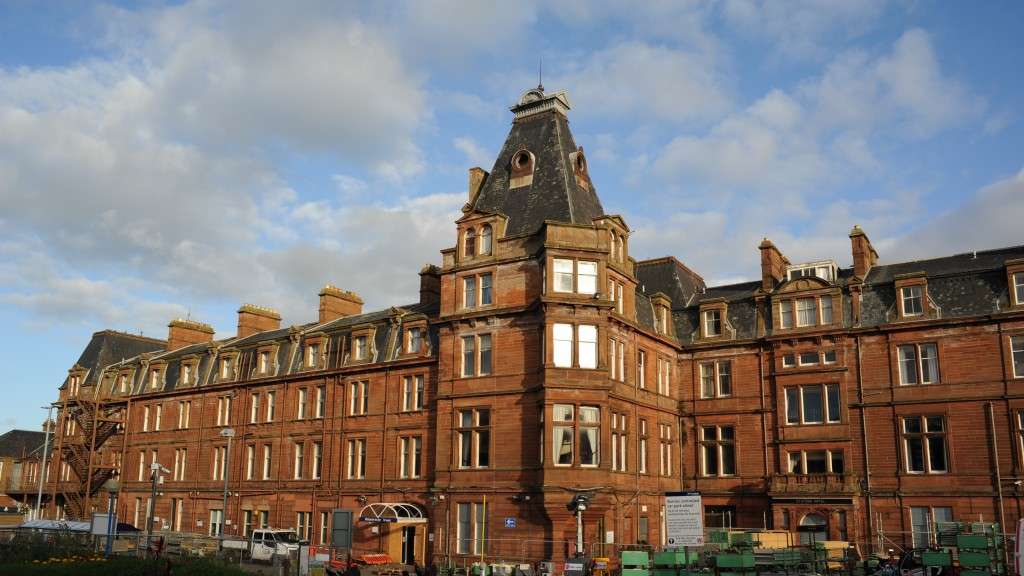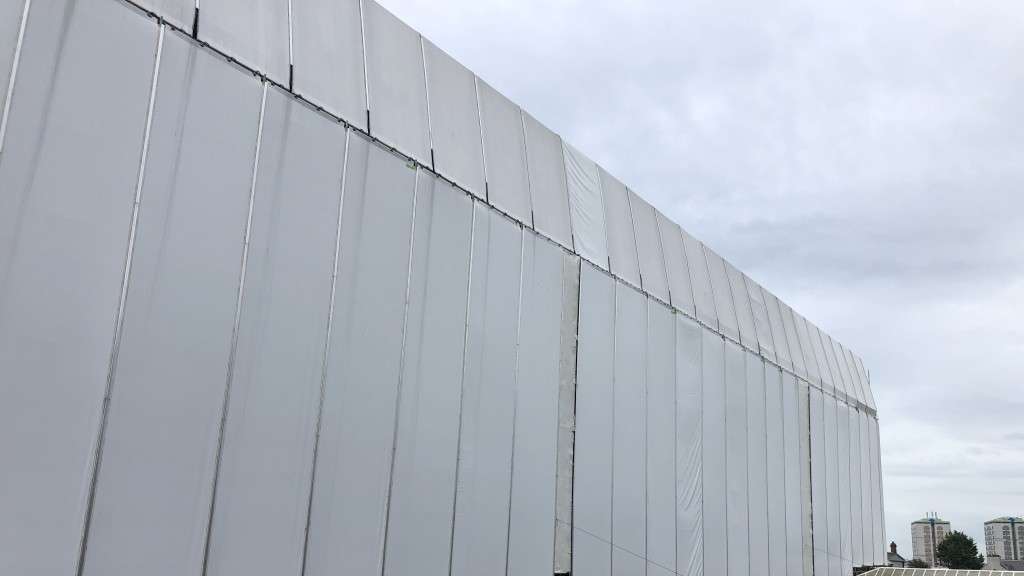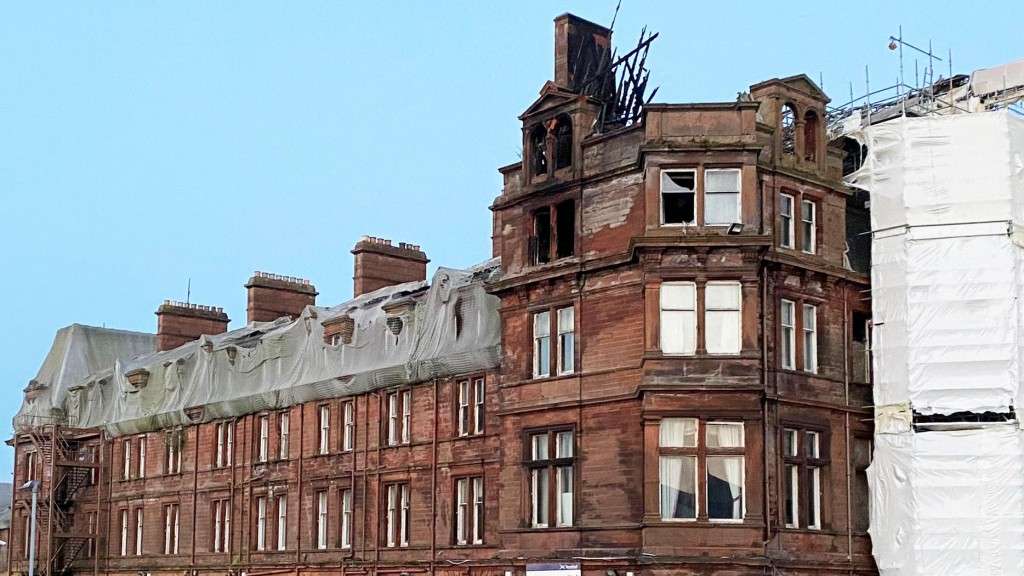PRESS RELEASE: Leading Scottish architects call for urgent action to save Ayr Station Hotel
Joint letter in The Times organised by SAVE after last week’s fire
4th October 2023
Leading Scottish architects and conservation experts have signed a joint letter to The Times arguing that Ayr Station Hotel can and should be saved.
The Category B-listed building was badly damaged in a suspected arson attack last week. The joint letter, published today, argues that if repaired, the landmark chateau-style building would lend itself to a variety of new uses and could act as a catalyst for the renaissance of the town, 30 miles south-west of Glasgow.
The letter, organised by SAVE Britain’s Heritage, is signed by 20 Scottish architecture and conservation experts and organisations, including Karen Anderson, president elect of RIAS (Royal Incorporation of Scottish Architects), Professor Gordon Murray, who worked on the refurbishment of Glasgow Central Station, and Ewan Lawson, partner at Simpson & Brown who has been involved in the restoration of several historic buildings damaged by serious fires, including Cameron House Hotel on the banks of Loch Lomond and Charles Rennie Mackintosh’s Glasgow School of Art.
Other signatories include Jocelyn Cunliffe, vice-chair of the Architectural Heritage Society of Scotland, Miles Glendinning, professor of architectural conservation, University of Edinburgh, Jonathan Potter, president of the Glasgow Institute of Architects (GIA), Bobby Jewell on behalf of Architects Climate Action Network (ACAN) Scotland, and Rory Olcayto, Scottish writer and former editor of the Architects’ Journal. The full list is below.
The letter notes that one needn’t look far to find examples of listed buildings that have been brought back to vibrant use after devastating fires. Less than a mile away, Seafield House – once home to the man who built the Forth Bridge – was named Best Renovation and Conversion project at last week’s Herald Property Awards, after reopening as luxury apartments 15 years after a blaze left it facing demolition.
Today’s joint letter calls for an urgent and comprehensive condition survey by an accredited historic buildings expert to understand the hotel’s structural condition following the fire and how much can be saved. This is different from the council’s building safety survey.
South Ayrshire Council’s most recently stated preferred option – demolition of the south wing – would leave a partially cleared site beside a derelict building – all in the ownership of an absentee owner. The letter calls on the council to begin compulsory purchase proceedings against the owner - something that has to happen in any case. These are the vital first steps to bring the building back into useful life.
Just 10 days before the fire SAVE published a report by specialist buildings engineer Ed Morton of the Morton Partnership which showed the building was in much better condition than previously thought. We called on elected Councillors to re-think their controversial demolition plans and to fully consider a refurbishment option which could include much-needed station facilities with a range of uses on the upper floors, from modern office suites to studio space. Not only would a refurbishment approach bring the listed building back to life, restoring one of the region’s great landmarks, but it would act as a signal of civic pride which could in turn trigger regeneration.
We believe the fire has not extinguished that hope.
The text of the letter in The Times and signatories:
Sir, The fire at Ayr Station Hotel was shocking but we strongly believe the building can and must be saved (report, Sep 27). This Category B-listed landmark played an important role in the life of Ayr for generations and its repair and reuse can be a catalyst for the town’s renaissance. We need look no further than Ayr’s own Seafield House for examples of listed buildings restored after serious fires.
Thanks to the swift actions of fire crews, much of the building has been saved. What is needed now is an urgent condition survey by an accredited historic buildings expert to establish the facts, as only then can informed decisions be made. At the same time the council must begin compulsory purchase proceedings against the absentee owner. These are the vital first steps to getting the wraps off and the building back in use.
Signed:
- Henrietta Billings, director, SAVE Britain’s Heritage
- Bobby Jewell, Architects Climate Action Network Scotland
- Karen Anderson, president elect, RIAS
- Professor Gordon Murray, past president, RIAS
- Robin Webster OBE, PPRIAS
- Malcolm Fraser, director, Fraser/Livingstone Architects, Edinburgh
- Jude Barber, director, Collective Architecture, Glasgow
- Ewan Lawson, partner and conservation architect, Simpson & Brown, Edinburgh
- Michael Dougall, director, O’DonnellBrown and past president, Glasgow Institute of Architects
- Alistair Scott, architect, former director, Smith Scott Mullan Associates
- Rory Olcayto, writer and critic, Pollard Thomas Edwards, London
- Jocelyn M Cunliffe, national vice-chair, Architectural Heritage Society of Scotland
- Iain J Wotherspoon, Architectural Heritage Society of Scotland, Strathclyde Group
- Miles Glendinning, professor of architectural conservation, University of Edinburgh
- David Cook, director, Glasgow Building Preservation Trust
- Jonathan Potter, president, Glasgow Institute of Architects
- Fiona Sinclair, past president, Glasgow Institute of Architects
- Ben Addy, managing director, Moxon Architects, Crathie & London
- Kinlay Laidlaw, chair, Ayrshire Architectural Heritage Trust
- Niall Murphy, director, Glasgow City Heritage Trust
- Thierry Lye, chairperson, New Glasgow Society
Subsequent support from: Gloria J. Lo, chair, Scottish Ecological Design Association (SEDA)
ENDS
Notes to editors:
1. For more information contact Elizabeth Hopkirk, editorial and communications manager at SAVE Britain’s Heritage, on 07811 116895 or 020 7253 3500 or elizabeth.hopkirk@savebritainsheritage.org.
2. The fire, the second in four months, broke out on Monday evening (Sept 25) and was brought under control by fire crews. There was a small flare-up this week, now believed to be fully extinguished. The site is under close supervision. Three teenagers have been arrested in connection with the events.
3. Ayr Station Hotel is a grand station building designed by Scottish engineer Andrew Galloway. It was built in 1885 and opened with 75 luxurious rooms, designed for affluent visitors who holidayed in Ayrshire and visited the fashionable races. Constructed in robust red sandstone, it was built in the grand French Renaissance chateau style with turrets and a clock tower. Inside it was grandly appointed with marble fireplaces. The historic category B-listed hotel was bought in 2014 by a now absentee owner who has failed to maintain the building or respond to enforcement action. As a result, the building has fallen into a state of disrepair and is the focus of regeneration plans for the town centre. It has been enshrouded in scaffolding to keep rainwater out since October 2018. In December 2022 South Ayrshire Councillors voted to pursue a demolition strategy for the South Wing of the hotel at a cost of £6.6 million. However a report, based on surveys commissioned by SAVE and published on 14th September 2023 - found that the building was in much better condition than previously known and that repair and reuse of the whole building would not cost significantly more than demolition. SAVE has been campaigning to rescue and bring life back to the hotel since 2016. In August 2022, we published a major report setting out a fundable and sustainable two-stage model to repair and transform this listed building. Our report includes a phased roadmap for repairing the historic structure and converting it for new use.
4. Read SAVE's press release issued immediately after the fire for more information.
5. SAVE Britain’s Heritage is an independent voice in conservation that fights for threatened historic buildings and sustainable reuses. We stand apart from other organisations by bringing together architects, engineers, planners and investors to offer viable alternative proposals. Where necessary, and with expert advice, we take legal action to prevent major and needless losses.



